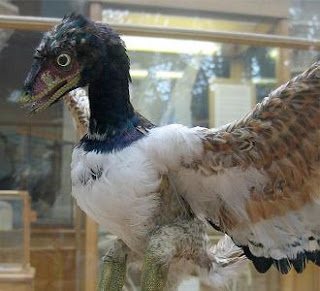 PZ Myers has requested an explanation of the difference between theistic evolution and intelligent design. Furthermore, he suggests that we imagine he's a Martian. This is a constructive suggestion, and I shall give it my best shot. I'm not sure what Martians are really like, so I'll presume that they are like PZ.
PZ Myers has requested an explanation of the difference between theistic evolution and intelligent design. Furthermore, he suggests that we imagine he's a Martian. This is a constructive suggestion, and I shall give it my best shot. I'm not sure what Martians are really like, so I'll presume that they are like PZ.
Background on Martians, for any human readers
Martians have good understanding of the natural world, and good appreciation of the areas where we don't have answers as yet. Technologically and scientifically, Martians are pretty much at the same position as humanity. Martians are social animals; who form stable family groups, and also like to engage constructively with others of their species. They are willing to put significant time and energy into their wider society, and put high importance on the well being of their fellows. They are curious about the world and seek to learn about it, and to share what they have learned, with passion and enthusiasm.
However, Martians have no concept of religion, or of a supernatural, or of Gods. They've heard about such things, since they regularly tap into the broadcasts we humans have been making; but this is one aspect of human society that Martians just don't get. They are inclined to think that humans who believe such things are, well, "a couple of tentacles short of a full cranium".
Welcome and Introduction
Honourable Ambassador, welcome to the third planet. You are aware, of course, that humans have a range of curious notions about the nature of the world. One common belief, in which you have expressed particular curiosity, is the notion of "God", an invisible intangible powerful conscious being. The reasons people believe such a thing are many and varied. None of them are particularly good. Humans are prone, from time to time, to have strange beliefs without any good evidence. A few other examples: We were meant to be together. I can still drive just fine. This shirt brings me luck.
The diversity of human beliefs about "God" is enormous, and many of them are in direct conflict with easily confirmed common knowledge about the world. Other beliefs about God are technically consistent, in the sense that they don't seem to make any empirical difference to anything we can effectively observe or sense.
Many people believe that such a being is responsible for making the world. The term "creator" is used, suggesting that in some way the putative intangible "God" causes other more tangible things to exist in the forms we can observe. This belief in a creator takes an enormous variety of forms.
Although none of these beliefs are well founded, it has still been convenient to classify some common themes. I shall attempt to describe three, and explain the utility for these broad classifications.
Creationism
This term is used for a belief that "God" used an act of special intervention to create things, in particular the universe, this particular planet, and the first living things. This belief has real substantive content (albeit ludicrous). It represents the creative act as a genuine alternative to the conventional discoveries we have made about how things were actually formed. It is common to hold that the interventions occurred comparatively recently, though there are exceptions. Creationists reject the notion that the form of living organisms, and humans in particular, can have evolved. They reject the discovery of biological evolution, the discovery that contemporary living forms developed from radically different ancestors by the agency of cumulative variation along a lineage modulated by natural selection.
Intelligent design
This is a form of creationism that has been shorn of any actual content. For political reasons they avoid explicit mention of God. In an effort to avoid refutations they avoid making any positive claims about, well, anything at all. They do reject the efficacy of natural processes and biological evolution in particular as the means by which living things take the forms we now observe, and their reasons and arguments are the same as those used by other creationists. They hold that living forms must have been "intelligently designed" instead – though they have no actual account of what that might mean. It's basically conventional creationism cut down to remove anything positive or any explicit mention of God.
Theistic evolution
The creationist position can be pared down even further, so that nothing is left except the statement that God is creator. To this, theistic evolution makes one new addition – explicit recognition of the validity of evolutionary biology. The theistic evolutionist considers that natural processes like evolution are the means by which the creator creates. How this works is unclear, and it is not something that is argued from an empirical basis.
Why distinguish intelligent design and theistic evolution?
Although intelligent design is a form of creationism, the same cannot be said for theistic evolution – at least given the ways of using terms I have described here. Creationism, including intelligent design, sees the action of God as something that is contrasted with the action of natural processes. Creationism is incompatible with evolutionary biology, because it is presented as an alterative to evolutionary biology.
Theistic evolution, on the other hand, recognizes evolution as a valid description of how living things came to have their currently observed physical forms. Theistic evolution sees God as in some sense responsible to the establishment of the evolutionary process itself; either by setting up initial conditions so as to enable evolution, or else by continuously maintaining the existence of a universe in which evolution can occur. There is no evidence for either proposition; but theistic evolution is not claimed to be a scientific model based on evidence; but rather a nebulous faith statement about some unevidenced responsibility of "God" for the ongoing operation of all aspects of the natural world.
The reason this distinction is of any interest to those who do not believe in God arises largely from a concern about science education.
Creationism, including intelligent design creationism, incorporates an explicit rejection of basic science. The cut down version of creationism called intelligent design is specifically tailored to avoid the social protections we have set up for education. Advocates for these notions are active in trying to degrade and distort science education, by inclusion of various trivially fallacious and pseudoscientific notions under the basically dishonest guise of alternative scientific models. They necessarily see the teaching of basic science as teaching a denial of their own beliefs.
Theistic evolution, on the other hand, is an unscientific add-on to conventional science. Most theistic evolutionists recognize that this add-on is not science, and do not seek to include it in the teaching of science. They do not regard the teaching of conventional science as a denial of their own beliefs.
Two design arguments
A convenient way to identify this subtle but significant distinction is to look at the perspective of the two groups on design. The arguments or apologetics given for beliefs about design and a creator come in two diametrically opposite forms.
Intelligent design and creationism claim that the natural processes studied by science are inadequate as an explanation for complex living things, and on that basis they claim that some other better explanation is required, which they label "design".
Theistic evolution considers that the natural processes studied by science are extraordinarily effective as an explanation for complex living things, and on that basis they claim that this fecundity was established by design.
One group sees design in the putative inadequacy of natural processes. The other sees design in the efficacy of natural processes.
Update: May 16 12:45. On reflection, I think the term "theistic evolution" is potentially confusing. What I really mean by that is "theism and evolution". The actual scientific descriptions of evolution remain totally unchanged. It's not a different theory of evolution; but the position of accepting perfectly conventional evolutionary biology while also being a theist. How theism can be consistent with evolutionary biology is a problem for theology, or for general theism/atheism debates. Such debates are fine by me; I engage in them also.
I was prompted to make this remark by reading these comments left at another blog, by Tyler DiPietro. I've also acknowledged below in comment #9.
Read the full post...



 new feed URI
new feed URI



















